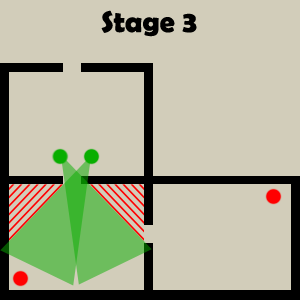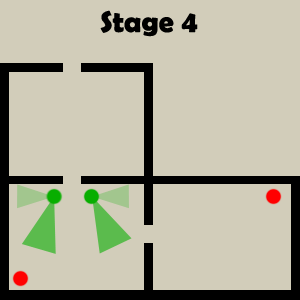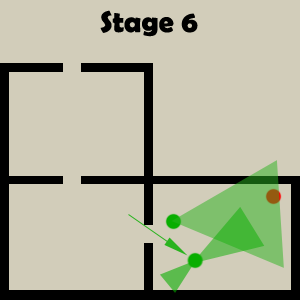Intro to tactical leadership
Page 1 of 1
 Intro to tactical leadership
Intro to tactical leadership
[size=14pt]1st Ranger Battalion
NCO School
Able Company[/size]
[size=12pt]Introduction to Tactical Leadership[/size]
Urban warfare is one of the worst possible theater of operations you can find yourself in as a leader. Danger is potentially present around every corner, window and building. Nowhere is safe and against a well-skilled, well prepared enemy. Innocent looking streets can become death traps. Fratricide is more common than any type other type of combat and is particularly dangerous in building clearance. Death rates in Urban Warfare can be as high as 90%.
Urban Operations is manpower intensive, slow and dangerous. As many as 5 to 6 soldiers per street could be required. Urban warfare has become an integral and unavoidable aspect of war. Stalingrad is an infamous example but more recently urban warfare has occurred in Chechnya, Baghdad and Afghanistan.
We take a look at the broad approach used by modern military in urban operations. A detailed look is beyond the scope of my article, as this is a general introduction.
The decision to commit forces to street operations is a complex and difficult one. Once the decision has been take to engage in urban operations, squad leaders should
* Assess the urban area to determine decisive points.
* Shape the operation to set the conditions for success.
* Precisely mass the effects of combat power to rapidly dominate the area.
Whilst there is a great deal of difference between cities and their layout, most maps have a few things in common.
1. Business fronts, Markets, store fronts, etc.
2. Core Area - the heart of the urban center and usually at the central point. The "downtown area", or business district. Because of high density, high rise building, easily destructible objects and multiple underground entrances, core areas are most difficult and manpower intensive to conduct offensive operations against.
3. Ribbon areas - normally along routes, and usually confined to two or three story buildings.
[size=12pt]Isolation[/size]
One of the import phases of urban operations in the concept of isolation. Isolation of enemy forces prevents them from support and reinforcements. Basra in Iraq was a notable example of the importance of isolation. American troops repeatedly attempted to "lock down" the city with a cordon to enhance the isolation of insurgents inside the city.
[size=12pt]Domination[/size]
Domination is a relative new military concept. The best example was "Shock and Awe" of the Gulf war - a concept rooted in domination. By dominating the battlefield with overwhelming power, an army seeks to maximize its advantage. In urban warfare, this extends to striking at the enemies center of gravity. This might be involve striking at an individual enemy leader, the enemy's combat skilled player, the enemy's communications capability, or a physical structure of defensive significance. This also means denying the enemy a chance to regroup.
Whether fighting on a small scale or large scale, all offensive operations include the elements of Surprise, Concentration, Tempo and Audacity.
[size=12pt]Surprise[/size]
Surprise can be achieved in a number of ways - timing, area of attack, and method of attack. Timing surprise can be achieved by attacking before the enemy expects it. Method surprise can occur when forces attack from the rear for example. Finally attacking an area the enemy thought safe can produce area surprise.
[size=12pt]Concentration[/size]
Concentrating firepower on an area of attack produces a dominating effect and prevents movement and re-positioning of enemy forces.
[size=12pt]Tempo[/size]
Urban areas can slow down the tempo of an overall attack, something defensive forces may seek to accomplish as they attempt to break up the tempo or advancement of offensive forces. Within urban warfare, the tempo may be high with regard to contact with enemy troops, unit fatigue and ammo consumption, but the tempo regarding areas secured may be slow.
[size=12pt]Audacity[/size]
Audacity simply means a plan of attack executed well. Audacity can lead to a bold surprise attack executed in a well thought out manner in an area the enemy least expected it. Studying map features can help in planning audacity into an attack plan.
[size=12pt]Types of Urban Offensive Actions[/size]
There are a number of urban offensive maneuvers available - envelopment, turning movement, infiltration, penetration, and frontal attack. Maneuvers can be combined with various types of attack - movement to contact, attack, exploitation, and pursuit. Maneuvers and types of attack should be combined to produce an effective operational plan.
There are 8 principles that guide the actions of soldiers in close quarter combat.
1. Move tactically and silently while securing the corridors to the room to be cleared. Semi-Automatic weapons should be placed in the front.
2. Arrive undetected at the entry to the room in the correct order of entrance, prepared to enter on a single command.
3. Enter quickly and dominate the room. Move immediately to positions that allows complete control of the room and provide unobstructed fields of fire.
4. Eliminate all enemy within the room by the use of fast, accurate, and discriminating fires.
5. Gain and maintain immediate control of the situation and all personnel in the room.
6. Confirm whether enemy casualties are wounded, dead, or escaped.
7. Immediately perform a cursory search of the building. Determine if a detailed search is required.
8. Maintain security at all times and be prepared to react to more enemy contact at any moment. Do not neglect rear security.
[size=12pt]Building Entry[/size]
Before entry to a building is gained the macro principles outlined above should be adhered to. Isolation of the building with routes suitable for infantry secured by automatic weapons and avenues of approach covered by riflemen. Suppression of enemy units using firepower and using smoke to obscure the movement of breach and entry units. Once entry has been obtained, teams move along covered and concealed routes and should work from the top down. Four man teams are the standard for room clearing. Anymore and friendly fire is a possibility, less and the roles undertaken by the remaining soldiers increases.
[size=12pt]Movement within Buildings[/size]
Hallways
Hallways can be clustered and dangerous. Two techniques are used depending on whether the hallway is wide or narrow. In a narrow hallway soldier 1 covers straight-ahead, 2 & 3 cover sides while four covers the rear. In a wide hallway, 2 & 3 cover the opposite side to the one they walk on.
Room Clearing
Most buildings have multiple rooms, and those rooms can have many doors, windows, or openings into other rooms. This is meant only for instruction purposes. Think of it as a scenario "in a vacuum" There are no outside forces at work here, just the solid basic principle of room clearing. First things first, typically a 2-man entry team is optimum, 3-man teams work too, but 3 is the max. The third man would provide rear support from a double envelopment by the enemy. That is, letting the our team breech the building, only to run around the outside and come back in the same way to kill our boys from behind. This can be done by second floor window, doors on ground floor, sewers leading to ground floors - any number of things. This is important to keep in mind. Secondly, the 2-man entry team will not want to expose their presence. This is done by not breaking the threshold of the door and not moving about directly in front of the threshold. Once it is broken, the element of surprise is lost and the team must move on that condition, or risk being eliminated. This is illustrated below:

Both men are "Stacked" upon one another, in a position that suits charging the building. The point man has a fix on a slice in the room. His field of view is very limited. If there are known enemy in this building, a preemptive grenade barrage is important. This will lead to disbursement of troops, whereby our forces can concentrate our firepower.
Stage 2 is the entry of the room. The pointman will want to "run the wall" on the opposite wall of which he was just watching. In the diagram below, he is the furthest on the left side of the page. He was just looking at the right side of the room - it makes no sense for him to draw down into the room in that direction. If there was an enemy in that room in that location, he would have already engaged. He needs to be looking in the opposite direction to ensure exposure is covered. As the room becomes clear, the pointman needs to start to systematically "slice the pie" into the adjacent room. He sees that the far corner is clear and notices a door. He needs to notify his team mate to keep eyes on the door.

Once the room is clear, Stage 3 ensues. At this point, since both of our boys have "creased" the room, that is, one on each side of the room, forming a crease from the door - They can do a bit more elaborate preemptive search. In the diagram, the blind spots are noted by red slashes. These are the areas that they will not be able to search before entering. It is important that they check these areas first, as it would lead to detrimental results if there were otherwise an enemy sitting and waiting for them. If the pointman notices the enemy in the corner, he may engage from the next room. Keep in mind after the initial gunfight, the enemy, or his buddies in the next room may launch grenades into the room held by our boys. If this is the case, the time to charge the room is now. They cannot lose ground by running out of the building entirely. They must press on at the second they see a grenade dropped at their feet. It's important that the operators signal who will be moving first as the most common screw-up here is both trying to get through the "fatal funnel" at the same time.

If the enemy has not engaged before they enter the room, in such a case that he may be behind furniture or otherwise shielded from view, the commencement of entering the room takes place. This is labeled as Stage 4. In stage 4, both of our boys need to quickly strafe-check the corner as mentioned before, and quickly strafe back so that the rest of the room is now in their field of view and they can eliminate the opposition in the room.

It is important that our boys do not cross the half-way point in the room. That is, crossing in front of the door leading to the next room where a lovely Jerry could be hiding. Once the previous room has been clear, they can stack on the wall leading to the next room, by staying out of sight. Again, they are preemptively searching the room before entering without completed exposing themselves with "Quick-peek" methods. The enemy knows we are here, but for whatever the case, had they not gone searching for us, and they are staying in their position. This is a common trait in realism for two reasons. 1. If he is the last man on the team, he is going to stay regardless. 2. If he is not the last man on the team, he is going to stay because he doesn't know how many are waiting outside, or worse, behind him. Blind spots are again noted in the diagram:

In diagram 6, we cover the fundamentals spoken in earlier stages. The pointman will move to suppress the largest area of the room, not already covered in his preemptive search. The secondary man moves to suppress the minor areas, such as the corner, and then moves to support the major area of operation, seen here:

Once the last man has been eliminated, you can cover this in your debrief as a successful room clearing operation, and chances are, it was paramount to your successful victory over lesser prepared forces.

*NOTE* Real situations requires flexibility within your framework of fundamentals. This guide is meant for perfect conditions. If a combat force wants to succeed in their mission, it is imperative that they remain flexible. Furniture, appliances, or other conditions INSIDE these rooms are important to note in practices and warm-up before matches. Things that will hinder speed, such as moving around said obstacles, is deadly.
And as always:
[size=14pt]Prior Preparation Prevents Piss Poor Performance
Copyright 2011, All rights reserved.
Do not use, alter, change, or quote outside of this thread without explicit written permission.
Page 1 of 1
Permissions in this forum:
You cannot reply to topics in this forum|
|
|
